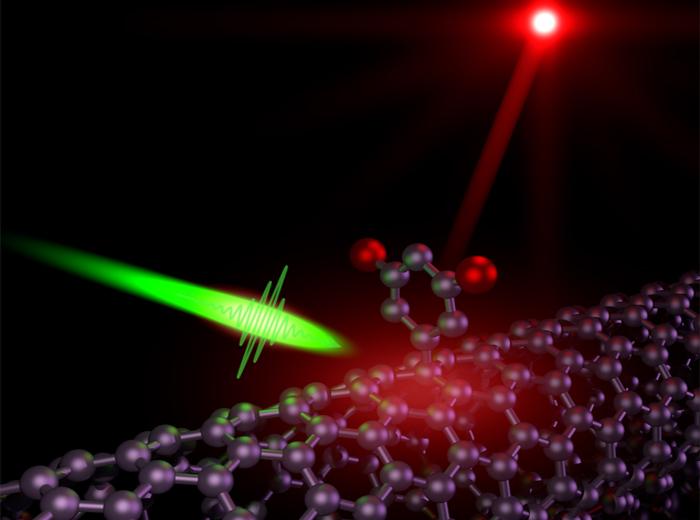Single-photon emitter has promise for quantum info-processing

Los Alamos National Laboratory researchers have produced the first known material capable of single-photon emission at room temperature and at telecommunications wavelengths, using chemically functionalized carbon nanotubes. These quantum light emitters are important for optically based quantum information processing and information security, ultrasensitive sensing, metrology and imaging needs and as photon sources for quantum optics studies. Credit: Los Alamos National Laboratory
Los Alamos National Laboratory has produced the first known material capable of single-photon emission at room temperature and at telecommunications wavelengths. These carbon nanotube quantum light emitters may be important for optically-based quantum information processing and information security, while also being of significant interest for ultrasensitive sensing, metrology and imaging needs and as photon sources for fundamental advances in quantum optics studies. The research was reported today in the journal Nature Photonics.
“By chemically modifying the nanotube surface to controllably introduce light-emitting defects, we have developed carbon nanotubes as a single photon source, working toward implementing defect-state quantum emitters operating at room temperature and demonstrating their function in technologically useful wavelengths,” said Stephen Doorn, leader of the project at Los Alamos and a member of the Center for Integrated Nanotechnologies (CINT).
“Ideally, a single photon emitter will provide both room-temperature operation and emission at telecom wavelengths, but this has remained an elusive goal. Up to now, materials that could act as single photon emitters in these wavelengths had to be cooled to liquid helium temperatures, rendering them much less useful for ultimate applications or scientific purposes,” he said.
A critical breakthrough in the CINT nanotube work was the ability of the team to force the nanotube to emit light from a single point along the tube, only at a defect site. The key was to limit defect levels to one per tube. One tube, one defect, one photon. . . . By emitting light only one photon at a time, one can then control the photons' quantum properties for storage, manipulation and transmission of information.
The CINT researchers were able to attain this degree of control using diazonium-based chemistry, a process they used to bind an organic molecule to the nanotube's surface to serve as the defect. The diazonium reaction chemistry allowed a controllable introduction of benzene-based defects with reduced sensitivity to natural fluctuations in the surrounding environment. Importantly, the versatility of the diazonium chemistry also permitted the researchers to access the inherent tunability of nanotube emission wavelengths.
The wavelengths (or color) of the photons produced in most other approaches had been too short for telecommunications applications, where photons need to be efficiently manipulated and transported within optical circuits. The team found that by choosing a nanotube of appropriate diameter, the single photon emission could be tuned to the essential telecom wavelength region.
The functionalized carbon nanotubes have significant prospects for further development, Doorn noted, including advances in functionalization chemistry; integration into photonic, plasmonic and metamaterials structures for further control of quantum emission properties; and implementation into electrically driven devices and optical circuitry for diverse applications.
###
Publication: “Tunable Room-Temperature Single-Photon Emission at Telecom Wavelengths from sp3 Defects in Carbon Nanotubes,” Nature Photonics (2017), available online at DOI: 10.1038/nphoton.2017.119. Researchers include Xiaowei He, Nicolai F. Hartmann, Xuedan Ma, Younghee Kim, Han Htoon and Stephen K. Doorn (Center for Integrated Nanotechnologies); Rachelle Ihly and Jeffrey L. Blackburn (National Renewable Energy Laboratory); Weilu Gao and Junichiro Kono (Rice University) and Yohei Yomogida, Atsushi Hirano, Takeshi Tanaka and Hiromichi Kataura (AIST, Japan).
Funding: This research was funded in part by the Laboratory Directed Research and Development (LDRD) program and performed in part at the Center for Integrated Nanotechnologies, a DOE Office of Science User Facility.
About Los Alamos National Laboratory
Los Alamos National Laboratory, a multidisciplinary research institution engaged in strategic science on behalf of national security, is operated by Los Alamos National Security, LLC, a team composed of Bechtel National, the University of California, BWX Technologies, Inc. and URS Corporation for the Department of Energy's National Nuclear Security Administration.
Los Alamos enhances national security by ensuring the safety and reliability of the U.S. nuclear stockpile, developing technologies to reduce threats from weapons of mass destruction, and solving problems related to energy, environment, infrastructure, health and global security concerns.
Media Contact
All latest news from the category: Physics and Astronomy
This area deals with the fundamental laws and building blocks of nature and how they interact, the properties and the behavior of matter, and research into space and time and their structures.
innovations-report provides in-depth reports and articles on subjects such as astrophysics, laser technologies, nuclear, quantum, particle and solid-state physics, nanotechnologies, planetary research and findings (Mars, Venus) and developments related to the Hubble Telescope.
Newest articles

NASA: Mystery of life’s handedness deepens
The mystery of why life uses molecules with specific orientations has deepened with a NASA-funded discovery that RNA — a key molecule thought to have potentially held the instructions for…

What are the effects of historic lithium mining on water quality?
Study reveals low levels of common contaminants but high levels of other elements in waters associated with an abandoned lithium mine. Lithium ore and mining waste from a historic lithium…

Quantum-inspired design boosts efficiency of heat-to-electricity conversion
Rice engineers take unconventional route to improving thermophotovoltaic systems. Researchers at Rice University have found a new way to improve a key element of thermophotovoltaic (TPV) systems, which convert heat…



